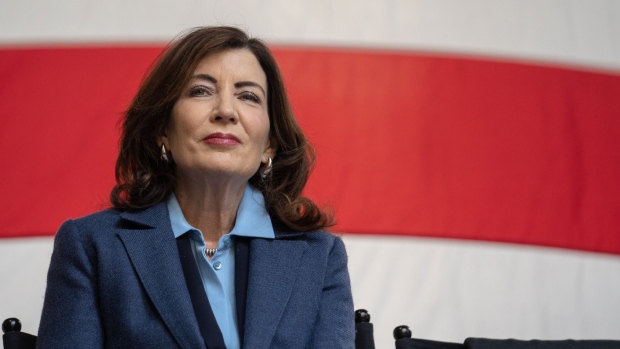Apr 10, 2024
NY Pension Costs to Rise by More Than $4 Billion Under New Plan
, Bloomberg News

(Bloomberg) -- Taxpayer contributions to New York City and state pensions would rise by more than $4 billion if Governor Kathy Hochul yields to a legislative proposal that would sweeten benefits for some public employees.
Lawmakers and unions argue that pension changes pushed through by former Governor Andrew Cuomo 12 years ago have made it more difficult to recruit public employees, contributing to a labor shortage and hurting services. The legislation, under consideration as part of the state budget, would benefit city and state employees affected by the overhaul but also put more of a financial burden on governments — facing $5 billion deficits — to fund the measure.
New York’s public unions and opponents called the 2012 reform — touted by Cuomo as a win for taxpayers and municipalities — an attack on the middle class on behalf of the wealthy.
Public employee pensions are calculated primarily on years of service and final average salary. Cuomo raised the retirement age for most city and state employees to 63 from 62, increased employee contributions and extended the average salary for computation to the last five years, for employees hired after April 1, 2012 – a group that makes up about half of the city and state workforce.
The new law calls for calculating pensions based on the average of the final three years, retroactively increasing pension payouts to the cohort and boosting benefits for not-yet-hired employees.
“We want investments in workers,” said the bill’s sponsor, state Senator Robert Jackson, a Democrat and chair of the Senate’s Civil Service and Pensions Committee.
Supporters of the proposal, backed by unions, said New York should stop wasting money on overtime. The city and state spent about $3.5 billion combined on overtime, according to recent comptrollers reports.
“Why should we have to pay overtime when we should hire more employees and use an incentive for employees to join state service?” said Jackson.
New York City’s payments to the five city pensions for civil employees, teachers, police officers, firefighters and non-teaching school workers, would rise by $2.2 billion, based on the current value of future contributions, according to the legislation. The city expects to spend $9.4 billion on pensions this fiscal year ending June 30.
Payments to the state and local employees’ retirement system would rise by $1.5 billion. The state teachers’ pension didn’t disclose the present value of future contribution increases, but the Empire Center for Public Policy, a fiscally conservative think tank, estimated the cost to taxpayers at $667 million.
“Governor Hochul’s Executive Budget makes record-setting investments in New York’s future while ensuring the state remains on a stable long-term fiscal trajectory, and she is working with the Legislature to craft a final budget that achieves these goals,” said Avi Small, a spokesperson for Hochul, in an email. Small didn’t address the pension proposal directly.
Read more: NY Budget Talks to Be Extended Amid Break to See the Eclipse
Budget hawks say the state and city, which are facing budget gaps of $5.2 billion and $5 billion, respectively, in fiscal 2026 can’t afford the tab.
“This is raw political power being used to squeeze billions from the public fisc,” said Ken Girardin, director of research at the Empire Center. “All you need is for the legislature and the governor to do the wrong thing once and that cost is permanently stuck on New Yorkers who haven’t even been born yet.”
Girardin said there’s no evidence that boosting pension payments will make it easier to recruit public employees.
The number of state employees, excluding state and city universities and state department of corrections workers, has increased by about 7,200 from the end of December 2021 to the last quarter of 2023, according to the Empire Center, which cited data from the state comptroller. The number of current state employees, 115,879, is still down more than 2,000 since before the pandemic. The state had 11,620 open positions in late December, according to Hochul’s executive budget.
Labor shortages are a widespread economic problem as baby boomers retire and workers seek higher pay and more flexible job arrangements, Girardin said.
In the aftermath of the Great Recession, states reduced benefits and increased employee contributions for new workers to shore up pensions and avoid tax increases and layoffs. Since 2009, New York was among the 39 states that increased employee contribution rates at one or more of their pension plans, and 40 states that reduced pension benefits, according to the National Association of State Retirement Administrators.
The latest pension reform “is a big test” for Hochul, a Democrat, said Girardin, adding that even if it is passed, “the unions won’t stop bellyaching.”
©2024 Bloomberg L.P.






